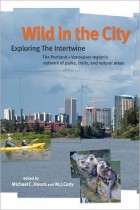 Edited by Michael C. Houck and M.J.Cody
Edited by Michael C. Houck and M.J.Cody
OSU Press, $24.95, 427 pages
In 2000, the Audubon Society of Portland published a new guide to the natural areas of the Portland region. Edited by Michael C. Houck and M.J. Cody, Wild in the City: A Guide to Portland’s Natural Areas provided the reader with descriptions of major natural areas in the region, along with short essays about natural history topics appropriate for the area by a variety of local naturalists.
A new edition of Wild in the City, subtitled Exploring the Intertwine: The Portland-Vancouver Region’s Network of Parks, Trails, and Natural Areas, adds over 12,000 acres of natural areas (such as Cooper Mountain and Graham Oaks Nature Parks) to the list since 11 years ago.
At the core of Wild in the City is The Intertwine, “the network of parks, trails, natural areas, and special places in the Portland-Vancouver region” that is “about providing people with connections to nature, to their communities, and to one another across urban and rural landscapes.” This book is all at once for walker and the hiker, for the paddler and the biker, for the beginning or seasoned naturalist, and most especially, as the children and nature activist Richard Louv writes in his foreword, for families with children.
Not only does Wild in the City describe with great detail the many places one could explore nature in the Portland region (over 90 locations), but it provides many short essays on far-ranging natural history topics, such as salamanders, Great Blue Herons (the city bird), pygmy owls, Peregrine falcons, “urban vermin,” coyotes, and salmon, and personal essays about particular spaces and their histories, like Forest Park, Sauvie Island, and the various watersheds. There are essays from the first edition, however, that are not repeated in the new edition, and that makes both editions worth owning.
A section of essays at the beginning of the book provides personal windows into the Portland region as a “sense of place.” Naturalist Robert Michael Pyle‘s essay “No Vacancy,” for example, looks further into why natural spaces, even “the little places, the corners and crannies and ravines, the urban greenspaces writ small,” must be part of our lives.
There is no better guide to make those natural spaces – weather a ditch along a trail cutting through your neighborhood or a banana slug-slimed trail at Tryon Creek State Natural Area – part of your everyday life than yourself, your family and friends, and a copy of Wild in the City.
Michael Barton
